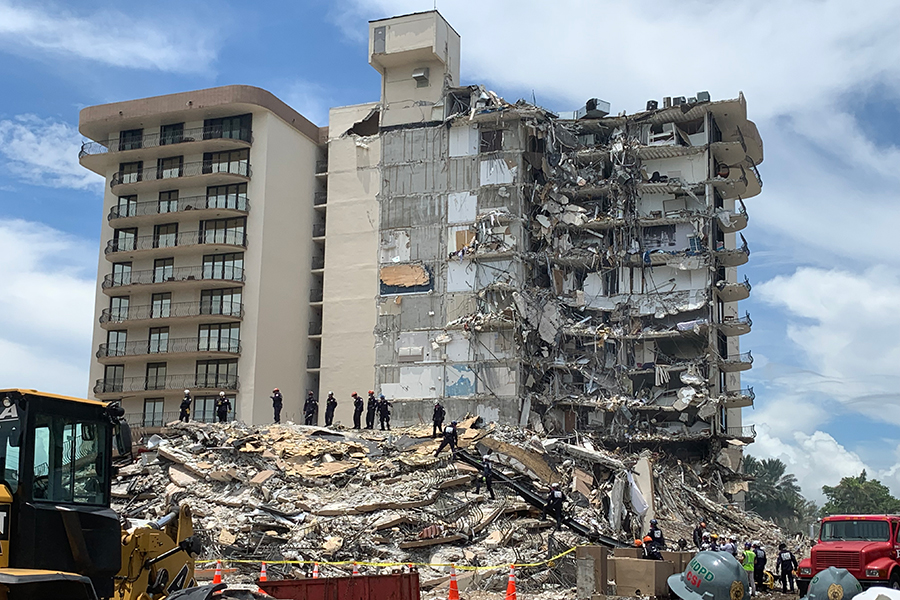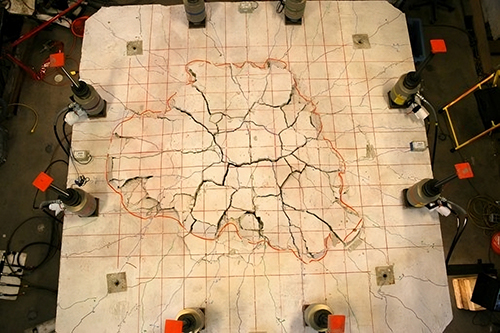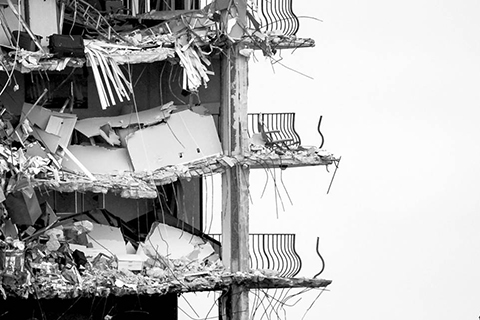By Julia Davis
CEE engineers tested full-scale slabs for NIST’s Surfside collapse investigation, helping improve national building safety standards.

The site of the Champlain Towers South partial collapse in Surfside, Florida. Photo courtesy of NIST.
Through a contract awarded by the National Institute of Standards and Technology (NIST), CEE researchers are contributing to the National Construction Safety Team (NCST) investigation into the 2021 partial collapse of the Champlain Towers South condominium in Surfside, Florida. As part of this effort, the University of Washington partnered with the University of Minnesota (UMN) to conduct 13 full-scale structural tests using concrete materials from South Florida, where the original building was constructed.

Top view of a slab after a punching shear test, showing cracks radiating outward from the center, where the column supported the slab from below. Photo courtesy of NIST.
Led by CEE Professor Dawn Lehman and Assistant Professor Travis Thonstad, with support from CEE structural engineering students, the UW team tested eight full-scale slab-column connections and three full-scale columns in the department’s Large-Scale Structural Engineering Testing Laboratory. These connections, where a vertical column supports a horizontal floor slab, are key to how a building transfers weight to its foundation.
“We have the capacity in our lab in terms of space and equipment to test these full-scale specimens,” says Lehman. “That was pivotal in being able to support this work.”
The testing investigates structural issues observed in the original building, with a focus on corrosion. To simulate the building’s aging, the UW team worked with NIST to implement an accelerated corrosion protocol that mimics the deterioration the slab experienced over 40 years. In addition, the tests at the UW and the UMN included long-term loading to simulate column damage that would have occurred over time due to the heavy loading of the building.
The project began in May 2023, after NIST selected the UW’s proposal to evaluate how these types of structural connections perform under different conditions. Testing began in February 2024 and was completed in spring 2025.
Related story

In the news
Professor weighs in on Surfside collapse
CEE Professor Dawn Lehman is featured in a Miami Herald article discussing the structural flaws that may have led to the Surfside condo collapse.
The slabs were cast using a concrete mix sourced from Florida materials to match the original building conditions.
Each slab measured over 10 feet by 10 feet and weighed more than 11,000 pounds. During testing, hydraulic jacks applied increasing loads to simulate real-world forces.
“We performed slab-column punching shear tests,” explains Ph.D. student Addie Lederman, who led the testing. “In these tests, the slab is supported by the column below it. As the load increases, the slab bends downward and eventually fails by punching shear, meaning that it cracks in a radiating pattern around the column and then drops suddenly, while the column itself stays in place.”
The UW’s work, alongside the testing at the UMN, supports NIST’s broader investigation and efforts to improve building safety nationwide.
"NIST is using data from these tests to refine the structural engineering models of the building," explains Jack Moehle, Research Civil Engineer at NIST and co-leader of the structural engineering team. "With these models, we can identify the most likely causes of the partial collapse and be better prepared to prevent similar failures in the future."
Originally published June 3, 2025